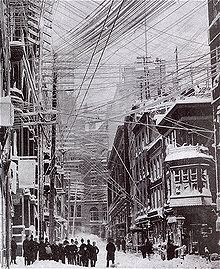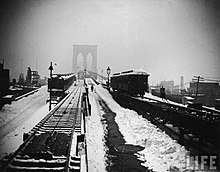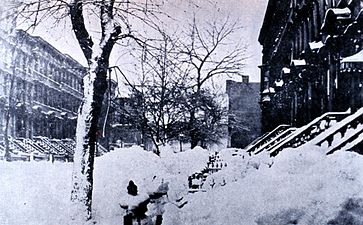Great Blizzard of 1888
 Surface analysis of Blizzard on March 12, 1888 at 10 p.m. | |
| Type | Extratropical cyclone Blizzard |
|---|---|
| Lowest pressure | 980 hPa (29 inHg) |
| Maximum snowfall or ice accretion | 58 inches (147 cm) |
| Fatalities | 400 fatalities |
| Damage | $25 million in 1888 (equivalent to $850 million in 2025) |
| Areas affected | Eastern United States, Eastern Canada |
The Great Blizzard of 1888, also known as the Great Blizzard of '88 or the Great White Hurricane (March 11–14, 1888), was one of the most severe recorded blizzards in American history. The storm paralyzed the East Coast from the Chesapeake Bay to Maine,[1][2] as well as the Atlantic provinces of Canada.[3] Snow fell from 10 to 58 inches (25 to 147 cm) in parts of New Jersey, New York, Massachusetts, Rhode Island, and Connecticut, and sustained winds of more than 45 miles per hour (72 km/h) produced snowdrifts in excess of 50 feet (15 m). Railroads were shut down and people were confined to their homes for up to a week.[3] Railway and telegraph lines were disabled, and this provided the impetus to move these pieces of infrastructure underground. Emergency services were also affected during this blizzard.
Storm details
[edit]

The weather was unseasonably mild just before the blizzard, with heavy rains that turned to snow as temperatures dropped rapidly.[3] On March 12, New York City dropped from 33 °F (1 °C) to 8 °F (−13 °C), and rain changed to snow at 1 A.M.[5] The storm began in earnest shortly after midnight on March 12 and continued unabated for a full day and a half. In a 2007 article, the National Weather Service estimated that this nor'easter dumped as much as 50 inches (130 cm) of snow in parts of Connecticut and Massachusetts, while parts of New Jersey and New York had up to 40 inches (100 cm).[2] Most of northern Vermont received from 20 inches (51 cm) to 30 inches (76 cm).[6]
Drifts averaged 30–40 feet (9.1–12.2 m), over the tops of houses from New York to New England, with reports of drifts covering three-story houses. The highest drift was recorded in Gravesend, Brooklyn at 52 feet or 16 metres. 58 inches (150 cm) of snow fell in Saratoga Springs, New York; 48 inches (120 cm) in Albany, New York; 45 inches (110 cm) in New Haven, Connecticut; and 22 inches (56 cm) in New York City.[7] The storm also produced severe winds; 80 miles per hour (129 km/h) wind gusts were reported, although the highest official report in New York City was 40 miles per hour (64 km/h), with a 54 miles per hour (87 km/h) gust reported at Block Island.[7] On March 13, New York City recorded a low of 6 °F (−14 °C), the coldest so late in the season, with the high rising to only 12 °F (−11 °C).[5]
Impacts
[edit]In New York, neither rail nor road transport was possible anywhere for days,[1] and drifts across the New York–New Haven rail line at Westport, Connecticut, took eight days to clear. Transportation gridlock as a result of the storm was partially responsible for the creation of the first underground subway system in the United States, which opened nine years later in Boston. As well as the opening of New York's first underground subway line in 1911, later expanding into the New York City Subway. [8][9] The New York Stock Exchange was closed for two days.[10] A full two day weather related closure would not occur again until Hurricane Sandy in 2012.[11]
Similarly, telegraph infrastructure was disabled, isolating Montreal and most of the large northeastern U.S. cities from Washington, D.C. to Boston for days. Following the storm, New York began placing its telegraph and telephone infrastructure underground to prevent their destruction.[12]
Fire stations were immobilized, and property loss from fire alone was estimated at $25 million (equivalent to $850 million in 2025).[1]
From the Chesapeake Bay through the New England area, more than 200 ships were either grounded or wrecked, resulting in the deaths of at least 100 seamen.[7] [13] Efforts were made to push the snow into the Atlantic Ocean. Severe flooding occurred after the storm due to melting snow, especially in the Brooklyn area, which was susceptible to flooding because of its topography.[7]
Not all areas were notably affected by the Blizzard of 1888; an article in the Cambridge Press published five days after the storm noted that the "fall of snow in this vicinity was comparatively small, and had it not been accompanied by a strong wind it would have been regarded as rather trifling in amount, the total depth, on a level, not exceeding ten inches".[14]
Roscoe Conkling, an influential Republican politician, died as a result of the storm after attempting to walk home during the blizzard.[15]
On 1 October 1888, an article appeared in the first issue of the National Geographic Society magazine about the great blizzard. It was written by Edward Everett Hayden and described the blizzard and the courageous and successful struggle, told by boat-keeper Robert Robinson, of the crew from the pilot-boat Charles H. Marshall, No. 3.[16]
Pictures
[edit]-
45th Street and Grand Central Depot, Manhattan, March 12
-
Park Place in Brooklyn, March 14
-
Brooklyn children after the blizzard
-
New Britain, Connecticut, March 13
-
Cythera, lost with all aboard in the blizzard
-
Bone Valley Trail, where a herd of cattle froze
-
14th Street, New York City, "just after the storm" (March 14)
References
[edit]- ^ a b c "The Blizzard of 1888; the Impact of this Devastating Storm on New York Transit".
- ^ a b "Biggest Snowstorms in the United States: From 1888 to Present". NWS Milwaukee/Sullivan, WI. Archived from the original on 24 March 2007. Retrieved 2007-12-21.
- ^ a b c Douglas, Paul (2004). Restless Skies. Barnes & Noble Publishing, Inc. pp. 12–13. ISBN 978-0-7607-6113-7.
- ^ "Building the invisible city". Virtual New York. Retrieved 2007-05-10.
- ^ a b The Blizzard of 1888: America’s Greatest Snow Disaster, Weather Underground, September 2, 2020
- ^ "Climate of Vermont" (PDF). National Climatic Data Center. Archived from the original (PDF) on 2008-02-29. Retrieved 2007-12-21.
- ^ a b c d "The Big One! A Review of the March 12–14, 1993 "Storm of the Century" [With comparisons to the Blizzard of 1888]". National Climatic Data Center. Archived from the original on 2016-02-27. Retrieved 2007-12-21.
- ^ "Blizzard shuts down Massachusetts". Massachusetts Foundation for the Humanities.
Perhaps the most important legacy of the Blizzard of 1888 was the Boston subway system. Alarmed by the paralysis and economic damage the storm caused, Boston decided to build a subway.
- ^ "The Blizzard of 1888; the Impact of this Devastating Storm on New York Transit".
There is no overstating the significant impact this tragedy had on the metropolis, especially on transportation. The resulting standstill on the elevated lines resulted in the city adopting a plan to build subways.
- ^ "New York Stock Exchange Special Closings, 1885–date" (PDF). Archived from the original (PDF) on 2007-09-25.
- ^ Redden, Molly. "The New York Stock Exchange Has a Long History of Shutdowns". MotherJones. Retrieved November 17, 2022.
- ^ "The Underground Grid". Museum of the City of New York. 2015. Retrieved December 9, 2023.
- ^ "On Mar 12 in weather history". NWS Northern Indiana Weather History. Retrieved 2007-12-21.
- ^ "The Great Storm" Cambridge Press, Cambridge, MA, 17 March 1888. Retrieved 29 November 2014.
- ^ O'Grady, Jim (January 27, 2015). "Bad Idea: The Most Powerful Man in America Walks Home Through the Blizzard of 1888". WNYC News. New York, NY.
- ^ "The Great Storm Of March 11–14, 1888". Everett Hayden. Retrieved 2020-12-14.
Further reading
[edit]- "In a Blizzard's Grasp" (PDF). The New York Times. March 13, 1888. Retrieved April 17, 2012.
- "The Great Storm of March 11 to 14, 1888", National Geographic Magazine, Vol. 1, No. 1, 1889 (audio) Accessed April 17, 2012
- Brunner, Borgna. "The Great White Hurricane". infoplease.com. Retrieved April 17, 2012.
- Christiano, G. J. "The Blizzard of 1888; the Impact of this Devastating Storm on New York Transit". nycsubway.org. Retrieved April 17, 2012.
- Kovatch, Breanne (March 11, 2019). "It's been 131 years since the Great White Hurricane. Do you know about it?". The Boston Globe. Retrieved March 12, 2019.
- Martí, José (2000). "New York Under the Snow". In Lopate, Phillip (ed.). Writing New York: A Literary Anthology (Paperback ed.). New York: Washington Square Press. pp. 271–277. ISBN 9780671042356. Retrieved 26 January 2015.
- Murphy, Jim (2006). Blizzard!: The Storm That Changed America. Scholastic. ISBN 978-0-590-67310-5.
External links
[edit]- NOAA: Major winter storms Accessed April 17, 2012
- Blizzard 1888, US Government images[permanent dead link] Accessed April 17, 2012
- National Snow and Ice Data Center: "Have Snow Shovel, Will Travel" Accessed April 17, 2012
- http://cslib.cdmhost.com/cdm/landingpage/collection/p15019coll17 Archived 2012-11-02 at the Wayback Machine Connecticut State Library Blizzard of 1888 Photographic Collection
- Blizzards in the United States
- Nor'easters
- 1888 meteorology
- 1888 natural disasters
- 1888 disasters in the United States
- Natural disasters in Connecticut
- Natural disasters in Maryland
- Natural disasters in Massachusetts
- Natural disasters in New Jersey
- Natural disasters in New York (state)
- Natural disasters in Pennsylvania
- Natural disasters in Washington, D.C.
- 1888 natural disasters in the United States
- 1888 in Canada
- Natural disasters in Canada
- March 1888 events
- Natural disasters in Prince Edward Island
- Natural disasters in Nova Scotia
- Natural disasters in New Brunswick







